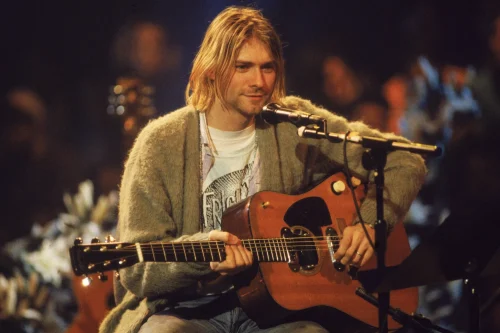In the early 1990s, Nirvana emerged as the torchbearers of the grunge movement, reshaping the musical landscape with their raw sound and introspective lyrics. Led by the enigmatic Kurt Cobain, the band’s meteoric rise to fame was punctuated by their breakthrough album, Nevermind, which became the anthem for a generation disillusioned by mainstream culture. Nirvana’s influence extended beyond their music, encapsulating the ethos of an era and leaving an indelible mark on the industry.
MTV Unplugged, launched in 1989, offered artists a unique platform to showcase their music in an intimate, acoustic setting. Stripping down to the bare essentials, performers had the opportunity to reveal the essence of their artistry, often delivering some of their most memorable and raw performances. The series became a cultural phenomenon, featuring a diverse range of artists from various genres, and setting the stage for some of the most iconic moments in music history.
Among the many memorable Unplugged sessions, Nirvana’s performance in New York stands out as a defining moment. Unlike their usual high-energy, distortion-heavy shows, this acoustic set offered a glimpse into the vulnerability and depth of Cobain and his bandmates. The choice of songs, the somber atmosphere, and Cobain’s haunting vocals created an experience that transcended the typical unplugged format. This performance not only showcased Nirvana’s versatility but also cemented their legacy as one of the most influential bands of all time.
Context and Background
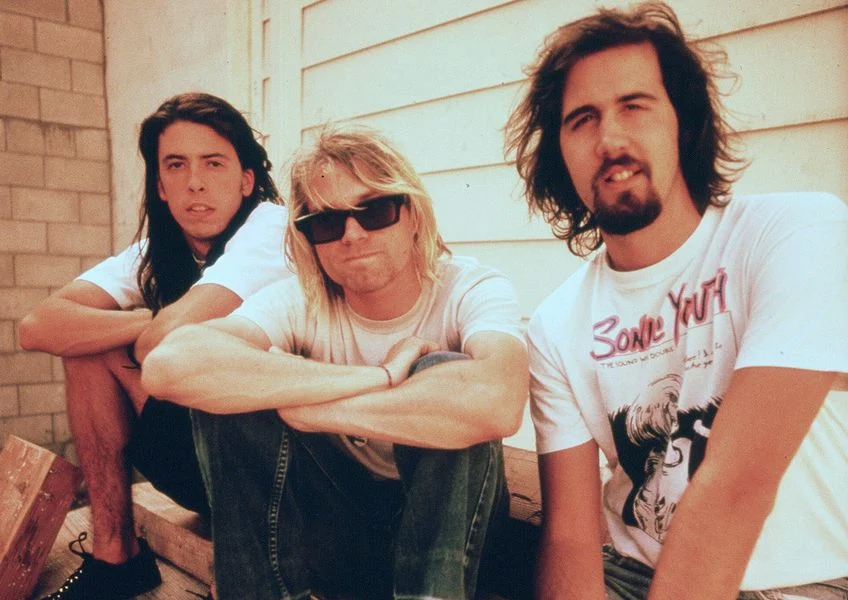
The State of Nirvana’s Career and the Music Industry in 1993
By 1993, Nirvana had ascended to the pinnacle of the music world. Their second album, Nevermind (1991), had catapulted them from the underground grunge scene of Seattle to international superstardom, thanks in large part to the massive success of their single “Smells Like Teen Spirit.” The band’s raw sound and Cobain’s introspective lyrics resonated deeply with a generation disillusioned by the excesses of 1980s rock and the burgeoning commercialism of the early ’90s.
However, with fame came immense pressure. Kurt Cobain, in particular, struggled with the demands of celebrity, the expectations of fans, and his own personal demons. By the time Nirvana released their third studio album, In Utero, in 1993, the band was grappling with internal tensions and Cobain’s worsening health. Despite these challenges, In Utero was critically acclaimed, reinforcing their status as the voice of a generation and solidifying their impact on the music industry.
Overview of the Grunge Movement and Nirvana’s Role in It
The grunge movement, rooted in the Pacific Northwest, was characterized by its fusion of punk rock’s raw edge with heavy metal’s powerful riffs. It emerged as a response to the polished, glamorized rock of the 1980s, emphasizing authenticity and emotional honesty. Alongside bands like Pearl Jam, Soundgarden, and Alice in Chains, Nirvana became one of the most prominent faces of grunge, known for their stripped-down aesthetic and anti-establishment ethos.
Nirvana’s music captured the angst and disillusionment of the era, with Cobain’s songwriting reflecting themes of alienation, pain, and rebellion. Their success not only brought grunge into the mainstream but also shifted the music industry’s focus towards more authentic, less commercialized acts. Nirvana’s influence extended beyond their music; their style and attitude defined a cultural moment and inspired countless artists who followed in their wake.
The Concept and Format of MTV Unplugged
MTV Unplugged, launched in 1989, was a groundbreaking television series that provided a platform for artists to perform their music in an acoustic, often more intimate setting. The concept was simple yet revolutionary: strip away the electric amplification and production, allowing the core elements of the music to shine through. This format not only highlighted the musicianship and vocal prowess of the artists but also often revealed new dimensions to familiar songs.
The series featured a diverse array of performers, from rock legends to pop icons, each bringing their unique sound to the acoustic stage. The intimacy of the setting often led to more personal and emotional performances, creating a special connection between the artists and their audience. Over the years, MTV Unplugged became known for its memorable moments and iconic performances, making it a coveted stage for artists looking to showcase their versatility and depth.
In this context, Nirvana’s decision to participate in MTV Unplugged in 1993 was both a bold and poignant move. As one of the most electrifying bands of the era, known for their high-energy performances, stripping down to an acoustic set presented a unique challenge and an opportunity to reveal a different side of their music and themselves.
Setting the Stage
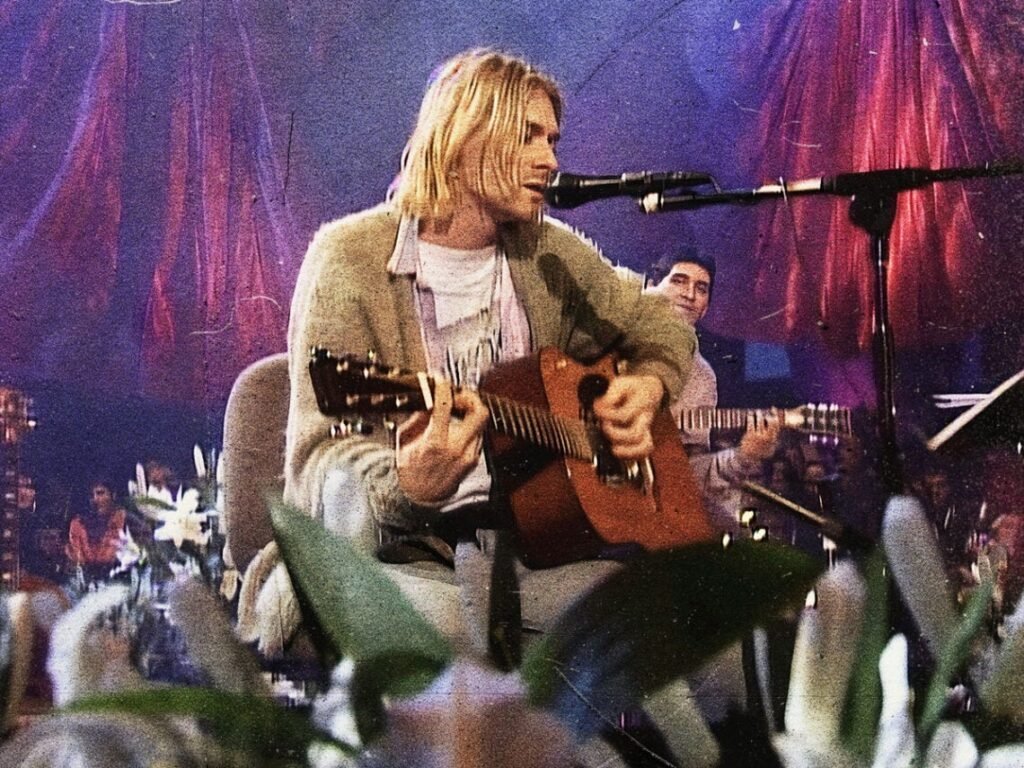
Description of the Atmosphere and Stage Design
The atmosphere of Nirvana’s MTV Unplugged performance was meticulously crafted to reflect an intimate and somber mood, mirroring the emotional depth of the music. The stage was adorned with stargazer lilies, black candles, and a chandelier, creating a funeral-like setting that was both haunting and beautiful. This visual aesthetic complemented the acoustic arrangements, setting the tone for a performance that felt both personal and profound. The subdued lighting and minimalistic décor focused attention squarely on the musicians, allowing the raw emotion of the performance to take center stage.
Setlist Choices
Nirvana’s setlist for their Unplugged performance was a thoughtful blend of their own hits, lesser-known tracks, and a surprising selection of covers. They opened with “About a Girl,” a track from their debut album Bleach, signaling from the outset that this would not be a conventional greatest hits show. The inclusion of songs like “Come As You Are” and “All Apologies” satisfied fans looking for familiar favorites, while deeper cuts like “Dumb” and “Pennyroyal Tea” showcased the band’s range and lyrical depth.
The covers were particularly notable, reflecting Cobain’s eclectic musical influences and paying homage to his heroes. The band performed David Bowie’s “The Man Who Sold the World,” Lead Belly’s “Where Did You Sleep Last Night,” and three songs by the Meat Puppets, with members of the Meat Puppets joining them on stage. These covers were not merely filler; they were integral to the performance, highlighting Nirvana’s respect for musical heritage and Cobain’s ability to reinterpret these songs with his unique voice and style.
The Absence of “Smells Like Teen Spirit” and Its Significance
Conspicuously absent from the setlist was “Smells Like Teen Spirit,” Nirvana’s biggest hit and the anthem that had propelled them to stardom. The decision to omit this song was significant. Cobain had often expressed ambivalence about the song’s overwhelming popularity and the way it had come to define the band. By leaving it out, Nirvana shifted the focus away from the commercial success and the expectations that came with it, allowing them to present a more authentic and unfiltered version of themselves.
This absence also underscored the performance’s introspective and understated nature. Rather than delivering a crowd-pleasing set of hits, Nirvana used the Unplugged stage to explore their musical roots and influences, offering a raw and vulnerable glimpse into their artistry. This decision ultimately reinforced the authenticity of the performance, highlighting the band’s integrity and commitment to their artistic vision.
Performance Highlights
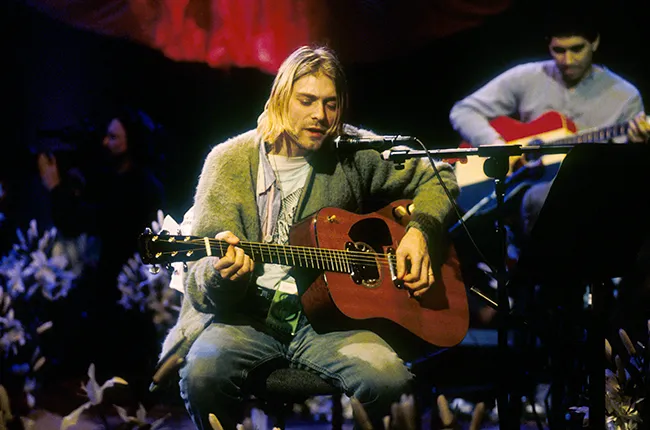
Analysis of Standout Performances
One of the most striking aspects of Nirvana’s MTV Unplugged in New York was the depth and variety of standout performances, each imbued with a unique emotional intensity.
“The Man Who Sold the World”: Nirvana’s cover of David Bowie’s “The Man Who Sold the World” was a revelation. Cobain’s interpretation transformed the song into something uniquely Nirvana, with his haunting vocals and the band’s stripped-down arrangement breathing new life into the track. The song’s melancholic tone and Cobain’s raw delivery resonated deeply with the audience, making it one of the most memorable moments of the evening.
“Where Did You Sleep Last Night”: The performance of Lead Belly’s “Where Did You Sleep Last Night” is often cited as the emotional pinnacle of the Unplugged set. Cobain’s voice, wavering between fragility and fury, captured the haunting despair of the song. The intensity reached its peak on the final, guttural scream of “shiver,” leaving the audience in stunned silence and highlighting Cobain’s ability to convey profound emotion through his music.
“Lake of Fire” and Other Meat Puppets Covers: Joined by the Meat Puppets themselves, Nirvana’s renditions of “Lake of Fire,” “Plateau,” and “Oh, Me” showcased a different facet of the band’s musical influences. These performances were marked by a collaborative spirit and mutual respect between the bands, adding depth and diversity to the setlist.
Kurt Cobain’s Vocal Delivery and Emotional Resonance
Kurt Cobain’s vocal performance during the Unplugged session was nothing short of extraordinary. His voice, often described as a blend of vulnerability and raw power, brought an emotional resonance to every song. In “About a Girl,” his soft, almost fragile delivery contrasted with the song’s underlying angst. In “All Apologies,” Cobain’s voice was both weary and defiant, encapsulating the song’s themes of regret and acceptance.
Cobain’s ability to channel his personal struggles into his vocal performance created a deeply intimate atmosphere. His vocals were not technically perfect, but it was this imperfection that made them so compelling. Each crack and strain in his voice added authenticity, drawing listeners into the raw emotion of the moment.
The Band’s Chemistry and Interactions with Guest Musicians
Nirvana’s chemistry as a band was on full display during the Unplugged performance. Despite the acoustic setting, they retained their signature intensity and cohesion. Krist Novoselic’s bass lines were melodic and supportive, providing a solid foundation for the performance. Dave Grohl’s restrained drumming showcased his versatility, adapting his typically powerful style to a softer, more nuanced approach suitable for the acoustic setting.
The interactions with guest musicians added a rich layer to the performance. The inclusion of Pat Smear on second guitar expanded the band’s sound, providing additional depth and texture. The collaboration with the Meat Puppets was particularly noteworthy. The mutual respect and camaraderie were evident, as the bands seamlessly blended their styles. These interactions highlighted Nirvana’s willingness to experiment and their appreciation for the broader musical landscape.
Cultural and Musical Impact
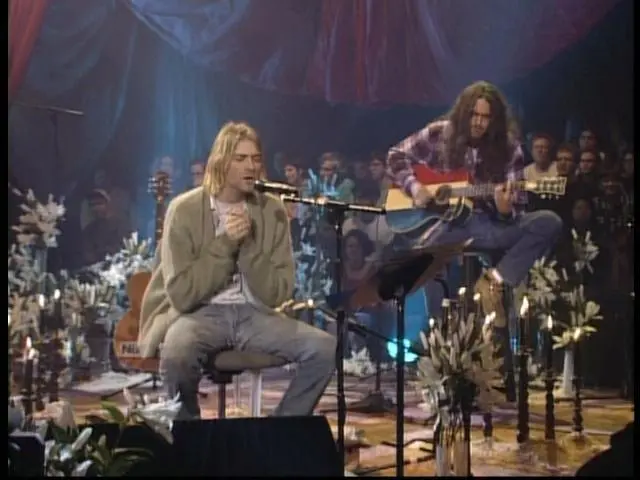
Reception by Fans and Critics at the Time of Airing
When Nirvana’s MTV Unplugged performance first aired on December 16, 1993, it was met with widespread acclaim from both fans and critics. Viewers were captivated by the raw, stripped-down renditions of their favorite songs and the unexpected covers that revealed a different side of the band. Critics praised the performance for its emotional depth and Cobain’s haunting vocals. The New York Times lauded it as a “transcendent” experience, while Rolling Stone highlighted the performance’s authenticity and intimacy. Fans, many of whom were used to Nirvana’s high-energy, electric shows, were moved by the vulnerability and sincerity of the acoustic set.
Long-Term Influence on Acoustic and Live Performance Styles
Nirvana’s Unplugged performance had a profound impact on acoustic and live performance styles. It demonstrated that a band known for its electrifying, grunge sound could succeed in an acoustic setting without losing its essence. This performance set a new standard for unplugged sessions, showcasing the power of acoustic arrangements to convey emotional intensity and connect with audiences on a deeper level.
In the years following Nirvana’s Unplugged session, many artists from various genres sought to replicate the authenticity and raw emotion that Cobain and his bandmates had achieved. The success of the performance encouraged other bands to explore acoustic formats, leading to a resurgence in acoustic albums and live performances. This influence extended beyond grunge, impacting artists in rock, pop, and alternative music who embraced the stripped-down, intimate style popularized by Nirvana’s Unplugged performance.
The Album’s Posthumous Release and Legacy
The Unplugged in New York album was released posthumously on November 1, 1994, seven months after Kurt Cobain’s tragic death. The album quickly rose to the top of the charts, debuting at number one on the Billboard 200. It was hailed as a poignant and fitting tribute to Cobain’s legacy, capturing the emotional core of his artistry in a way that resonated deeply with fans and critics alike.
The album’s success further cemented Nirvana’s status as one of the most influential bands of the 1990s. Tracks like “Where Did You Sleep Last Night” and “The Man Who Sold the World” became defining moments in Nirvana’s discography, illustrating Cobain’s versatility and the band’s ability to transcend their grunge roots. The raw, unfiltered nature of the performance offered a stark contrast to the heavily produced music that dominated the era, reinforcing the enduring appeal of authenticity in art.
Over the years, Unplugged in New York has been recognized as one of the greatest live albums of all time. It continues to be celebrated for its emotional intensity, musical innovation, and the intimate glimpse it provides into the soul of Kurt Cobain. The performance remains a touchstone for musicians and fans alike, a testament to Nirvana’s enduring impact on the cultural and musical landscape.
